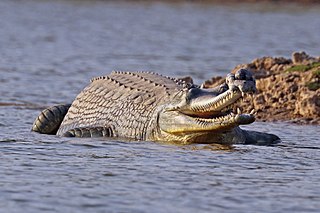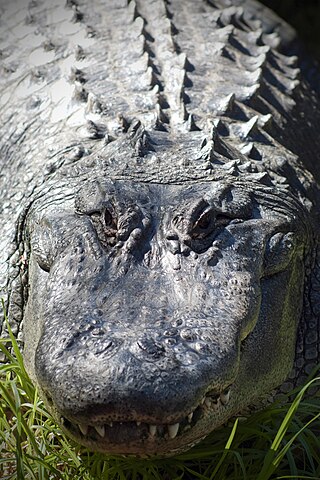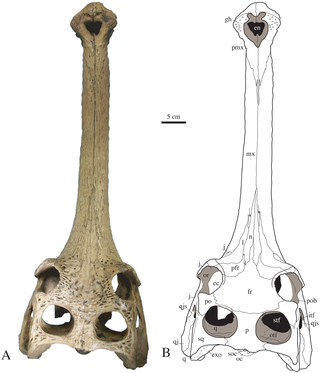
Gavialinae is a subfamily of large semiaquatic crocodilian reptiles, resembling crocodiles, but with much thinner snouts. Gavialinae is one of the two major subfamilies within the family Gavialidae - the other being the subfamily Tomistominae, which contains the false gharial and extinct relatives.

Gavialidae is a family of large semiaquatic crocodilians with elongated, narrow snouts. Gavialidae consists of two living species, the gharial and the false gharial, both occurring in Asia. Many extinct members are known from a broader range, including the recently extinct Hanyusuchus. Gavialids are generally regarded as lacking the jaw strength to capture the large mammalian prey favoured by crocodiles and alligators of similar size so their thin snout is best used to catch fish, however the false gharial has been found to have a generalist diet with mature adults preying upon larger vertebrates, such as ungulates.

Gavialis is a genus of crocodylians that includes the living gharial Gavialis gangeticus and one known extinct species, Gavialis bengawanicus.G. gangeticus comes from the Indian Subcontinent, while G. bengawanicus is known from Java. Gavialis likely first appeared in the Indian Subcontinent in the Pliocene and dispersed into the Malay Archipelago through a path called the Siva–Malayan route in the Quaternary. Remains attributed to Gavialis have also been found on Sulawesi and Woodlark Island east of the Wallace Line, suggesting a prehistoric lineage of Gavialis was able to traverse marine environments and reach places possibly as far as western Oceania.

The gharial, also known as gavial or fish-eating crocodile, is a crocodilian in the family Gavialidae and among the longest of all living crocodilians. Mature females are 2.6 to 4.5 m long, and males 3 to 6 m. Adult males have a distinct boss at the end of the snout, which resembles an earthenware pot known as a ghara, hence the name "gharial". The gharial is well adapted to catching fish because of its long, narrow snout and 110 sharp, interlocking teeth.

Tomistoma is a genus of gavialid crocodilians. They are noted for their long narrow snouts used to catch fish, similar to the gharial. Tomistoma contains one extant (living) member, the false gharial, as well as potentially several extinct species: T. cairense, T. lusitanicumT. coppensi, and T. dowsoni. However, these species may need to be reclassified to different genera as studies have shown them to be paraphyletic, for example: previously assigned species T. taiwanicus from Taiwan, is reclassified to the genus Toyotamaphimeia, and T. dowsoni should be excluded from Tomistoma based on phylogenetic analysis.

Alligatoroidea is one of three superfamilies of crocodylians, the other two being Crocodyloidea and Gavialoidea. Alligatoroidea evolved in the Late Cretaceous period, and consists of the alligators and caimans, as well as extinct members more closely related to the alligators than the two other groups.
Dollosuchoides, colloquially known as the Crocodile of Maransart, is an extinct monospecific genus of gavialoid crocodilian, traditionally regarded as a member of the subfamily Tomistominae. Fossils have been found in the Brussel Formation of Maransart, Belgium and date back to the middle Eocene.

Dollosuchus is an extinct monospecific genus of tomistomine crocodilian originally named as a species of Gavialis. It is a basal form possibly related to Kentisuchus, according to several phylogenetic analyses that have been conducted in recent years, and is the oldest known tomistomine to date. Fossils have been found from Belgium and the United Kingdom. It had large supratemporal fenestrae in relation to its orbits, similar to Kentisuchus and Thecachampsa.
Eogavialis is an extinct genus of eusuchian crocodylomorph, usually regarded as a gavialoid crocodylian. It superficially resembles Tomistoma schlegelii, the extant false gharial, and consequently material from the genus was originally referred to Tomistoma. Indeed, it was not until 1982 that the name Eogavialis was constructed after it was realised that the specimens were from a more basal form.

Gryposuchus is an extinct genus of gavialid crocodilian. Fossils have been found from Argentina, Colombia, Venezuela, Brazil and the Peruvian Amazon. The genus existed during the Miocene epoch. One recently described species, G. croizati, grew to an estimated length of 10 metres (33 ft). Gryposuchus is the type genus of the subfamily Gryposuchinae, although a 2018 study indicates that Gryposuchinae and Gryposuchus might be paraphyletic and rather an evolutionary grade towards the gharial.
Ikanogavialis is an extinct genus of gavialid crocodilian. Fossils have been found in the Urumaco Formation in Urumaco, Venezuela and the Solimões Formation of Brazil. The strata from which remains are found are late Miocene in age, rather than Pliocene as was once thought. A possible member of this genus survived into the Late Holocene on Muyua or Woodlark Island in Papua New Guinea.

Kentisuchus is an extinct genus of gavialoid crocodylian, traditionally regarded as a member of the subfamily Tomistominae. Fossils have been found from England and France that date back to the early Eocene. The genus has also been recorded from Ukraine, but it unclear whether specimens from Ukraine are referable to Kentisuchus.

Crocodyloidea is one of three superfamilies of crocodilians, the other two being Alligatoroidea and Gavialoidea, and it includes the crocodiles. Crocodyloidea may also include the extinct Mekosuchinae, native to Australasia from the Eocene to the Holocene, although this is disputed.

Gavialoidea is one of three superfamilies of crocodylians, the other two being Alligatoroidea and Crocodyloidea. Although many extinct species are known, only the gharial Gavialis gangeticus and the false gharial Tomistoma schlegelii are alive today, with Hanyusuchus having become extinct in the last few centuries.

Tomistominae is a subfamily of crocodylians that includes one living species, the false gharial. Many more extinct species are known, extending the range of the subfamily back to the Eocene epoch. In contrast to the false gharial, which is a freshwater species that lives only in southeast Asia, extinct tomistomines had a global distribution and lived in estuaries and along coastlines.

Brevirostres is a paraphyletic group of crocodilians that included alligatoroids and crocodyloids. Brevirostres are crocodilians with small snouts, and are distinguished from the long-snouted gharials. It is defined phylogenetically as the last common ancestor of Alligator mississippiensis and Crocodylus niloticus and all of its descendants. This classification was based on morphological studies primarily focused on analyzing skeletal traits of living and extinct fossil species, and placed the gharials outside the group due to their unique skull structure, and can be shown in the simplified cladogram below:
"Crocodylus" megarhinus is an extinct species of crocodile from the Eocene of Egypt. A partial skull was found by British paleontologist Charles William Andrews in the Fayum Depression. Andrews named Crocodylus megarhinus in 1905 on the basis of the holotype skull. A complete skull was also uncovered from Egypt in 1907 but was not recognized as "C." megarhinus until 1927.

Planocraniidae is an extinct family of eusuchian crocodyliforms known from the Paleogene of Asia, Europe and North America. The family was coined by Li in 1976, and contains three genera, Boverisuchus, Duerosuchus and Planocrania. Planocraniids were highly specialized crocodyliforms that were adapted to living on land. They had extensive body armor, long legs, and blunt claws resembling hooves, and are sometimes informally called "hoofed crocodiles".

Gavialis bengawanicus is an extinct species of crocodilian that is related to the modern Indian gharial. Fossils have been found in Thailand and Indonesia. The type locality is at Trinil.

Longirostres is a clade of crocodilians that includes the crocodiles and the gavialids, to the exclusion of the alligatoroids. Defined in 2003 by Harshman et al., Longirostres is a crown group defined phylogenetically as including the last common ancestor of Crocodylus niloticus and Gavialis gangeticus and all of its descendants.


















